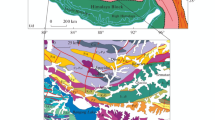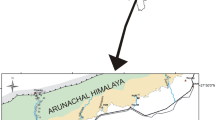Abstract
Tertiary sandstones collected from southwest Sarawak, Malaysia, were analyzed to decipher their provenance, weathering, and tectonic setting. The studied sandstones have a sublitharenite composition and are dominantly composed quartz with little mica and feldspar, and a small amount of volcanic fragments. These sandstones were generally derived from quartz-rich recycled orogenic sources. They have relatively high SiO2 content with low Na2O, CaO, MnO, and MgO contents. Values of Chemical Index of Alteration (CIA) of these rock samples vary from 71 to 93, with an average of 81, implying intense chemical alteration during weathering. A felsic igneous source is suggested by a low concentration of TiO2 compared to CIA, enrichment of Light Rare Earth Elements, depletion of Heavy Rare Earth Elements, and negative Eu anomalies. A felsic origin is further supported by a Eu/Eu* range of 0.65–0.85 and high Th/Sc, La/Sc, La/Co, and Th/Co ratios. This work presents the first reported geochemical data of Tertiary sandstones of the Sarawak Basin. These data led us to conclude that the sandstones were dislodged from recycled orogenic sources and deposited in a slowly subsiding rifted basin in a passive continental tectonic setting.












Similar content being viewed by others
References
Bauluz B, Mayayo MJ, Fernandez-Nieto C, Gonzalez-Lopez JM (2000) Geochemistry of Precambrian and Paleozoic siliciclastic rocks from the Iberian Range (NE Spain): implications for source area weathering, sorting, provenace, and tectonic setting. Chem Geol 168:135–150
Bhatia MR (1983) Plate tectonics and geochemical composition of sandstones. J Geol 91:611–627
Bhatia MR (1985) Rare earth element geochemistry of Australian Paleozoic graywackes and mudrocks: provenance and tectonic control. Sed Geol 45:97–113
Bhatia MR, Crook KAW (1986) Trace element characteristics of greywackes and tectonic setting discrimination of sedimentary basin. Contrib Miner Petrol 92:181–193
Crichton JG, Condie KC (1993) Trace elements as source indicators in cratonic sediments: a case of study from the early Proterozoic Libby Creek Group, southwestern Wyoming. J Geol 101:319–322
Crook KAW (1974) Lithogenesis and geotectonics: the significance of compositional variation in flysch arenites (grawckes). Soc Econ Paleontol Min Special Publication 19:304–310
Cullers RL (1994) The controls on the major and trace element variation of shales, siltstones, and sandstones of Pennsylvanian-Permian age from uplifted continental blocks in Colorado to platform sediment in Kansas, USA. Geochim Cosmochim Acta 58:4955–4972
Cullers RL (1995) The controls on the major- and trace-element evolution of shales, siltstones and sandstones of Ordovician to tertiary are in the Wet Mountains region, Colorado, U.S.A. Chem Geol 123:107–131
Cullers RL (2000) The geochemistry of shales, siltstones and sandstones of Pennsylvanian-Permian age, Colorado, USA: implications for provenance and metamorphic studies. Lithos 51:181–203
Cullers RL, Chaudhuri S, Kilbane N, Koch R (1979) Rare-earths in size fractions and sedimentary rocks of Pennsylvanian-Permian age from the mid-continent of the U.S.A. Geochim Cosmochim Acta 43:1285–1301
Cullers RL, Basu A, Suttner L (1988) Geochemical signatureof provenance in sand-size material in soils and stream sedimentsnear the Tobacco Root batholith, Montana, USA. Chem Geol 70:335–348
Dabard MP (1990) Lower Brioverian formations (Upper Proterozoic) of the Armorican Massif (France): geodynamic evolution of source areas revealed by sandstone petrography and geochemistry. Sed Geol 69:45–58
Dickinson WR, Suczek CA (1979) Plate tectonics and sandstone compositions. Am Assoc Pet Geol Bull 63:2164–2182
Dickinson WR, Beard LS, Brakenridge GR, Erjavec JL, Ferguson RC, Inman KF, Knepp RA, Lindberg FA, Ryberg PT (1983) Provenance of North American Phanerozoic sandstones in relation to tectonic setting. Geol Soc Am Bull 94:222–235
Feng R, Kerrich R (1990) Geochemistry of fine-grained clastic sediments in the Archean Abitibi greenstones belt, Canada: implications for provenance and tectonic setting. Geochim Cosmochim Acta 54:1061–1081
Haile NS (1974) Borneo In: Spencer AM (ed) Mesozoic—cenozoic orogenic belts: data for orogenic studies. Geological Society of London, Special Publication 4:333–347
Hall R (2002) Cenozoic geological and plate tectonic evolution of SE Asia and the SW Pacific: computer-based reconstruction, model and animations. J Asian Earth Sci 20:353–431
Hall R, Nichols G (2002) Cenozoic sedimentation and tectonics in Borneo: climatic influence on orogenesis. Geol Soc Lond, Special Publication 191:5–22
Herron MM (1988) Geochemical classifi cation of terrigenous sands and shales from core or log data. J Sediment Petrol 58:820–829
Holloway NH (1982) North Palawan Block, Philippines its relationship to the Asian mainland and role in the evolution of South China Sea. Am Assoc Pet Geol Bull 66:1355–1383
Hutchison CS (1996) The ‘Rajang accretionary prism’ and ‘Lupar Line’ problem of Borneo. Geol Soc, London 106:247–261
Hutchison CS (2005) Geology of North-West Borneo: Sarawak, Brunei and Sabah. Elsevier, Amsterdam
Ingersoll RV, Bulard TF, Ford RL, Grimn JP, Pickle JP, Sares SW (1984) The effect of grain size on detrital modes: a test of the Gazzi-Dickinson Point Counting method. J Sediment Petrol 54:103–116
James DMD (1984) The geology and hydrocarbon resources of Negara Brunei Darulsalam. Special publication, Brunei Museum and Brunei Shell Petroleum Company
Mat-Zin IC (1996) Tertiary tectonics and sedimentation history of the Sarawak basin, east Malaysia. Ph.D. Thesis, Durham University
McLennan SM (2001) Relation between the trace element composition of sedimentary rocks and upper continental crust. Geochem Geophys Geosyst. doi:10.1029/2000GC000109
McLennan SM, Hemming S, McDaniel DK, Hanson GN (1993) Geochemical approaches to sedimentation, provenance and tectonics. Geol Soc Am Spec Pap 284:295–303
Metcalfe I (2011) Tectonic framework and Phanerozoic evolution of Sundaland. Gondwana Res 19:3–21
Mielke JE (1979) Composition of the Earth’s crust and distribution of the elements. In: Siegel FR (ed) Review of research on modern problems in geochemistry, Paris. International Association for Geochemistry and Cosmochemistry, Earth Science Series, 16:13–37
Moss SJ (1998) Embaluh Group turbidities in Kalimantan: evolution of the remnant oceanic basin in Borneo during the Late Cretaceous and Paleocene. J Geol Soc, London 155:509–524
Nance WB, Taylor SR (1976) Rare earth element patterns and crustal evolution-I. Australian post-Archean sedimentary rocks. Geochim Cosmochim Acta 40:1539–1551
Nance WB, Taylor SR (1977) Rare earth element pat-terns and crustal evolution-II. Archean sedimentary rocks from Kalgoorlie, Australia. Geochimica et Cosmochimica Acta 41:225–231
Nesbitt HW, Young GM (1982) Early Proterozoic climates and plate motions inferred from major element chemistry of lutites. Nature 299:715–717
Nesbitt HW, Markovics G, Price RC (1980) Chemical processes affecting alkalines and alkaline earths during continental weathering. Geochim Cosmochim Acta 44:1659–1666
Prouteau G, Maury RC, Pubellier M, Cotten J, Bellon H (2001) Le magmatisme post-collisionnel du Nord-Ouest de Borneo, produit de la fusion d’un fragment de croute oceanique ancre dans le manteau superieur. Bull Soc Geol Fr 172:319–332
Rahman MJJ, Suzuki S (2007) Geochemistry of sandstones from the Miocene Surma Group, Bengal Basin, Bangladesh: implications for Provenance, tectonic setting and weathering. Geochem J 14:415–428
Roser BP, Korsch RJ (1986) Determination of tectonic setting of sandstone–mudstone suites using SiO2 content and K2O/Na2O ratio. J Geol 94:635–650
Roser BP, Korsch RJ (1988) Provenance signatures of sandstone–mudstone suites determined using discriminant function analysis of major-element data. Chem Geol 67:119–139
Tan DNK (1979) Lupar valley, west Sarawak, Malaysia. Geological Survey of Malaysia, Report 13
Tan DNK (1984) Paleocurrents in the Tertiary sedimentary deposits in western Sarawak. Bull Geol Soc Malaysia 17:257–264
Tan DNK (1986) Palaeogeographic development of west Sarawak. Bull Geol Soc Malaysia 19:39–49
Tan DNK, Lamy JM (1990) Tectonic evolution of the NW Sabah continental margin since the Late Eocene. Bull Geol Soc Malaysia 27:241–260
Tate RB (2001) Geological map of Borneo Island, CD-Rom published by the Geological Society of Malaysia, Kuala Lumpur
Taylor SR, McLennan SM (1985) The continental crust: its composition and evolution. Blackwell, London
Verma SP, Armstrong-Altrin SJ (2013) New multi-dimensional diagrams for tectonic discrimination of siliciclastic sediments and their application to Precambrian basins. Chem Geol 355:117–133
Wilford GE (1955) The geology and mineral resources of the Kuching-Lundu area, west Sarawak including the Bau Mining District. Kuching, Sarawak: Geological Survey Dept., British Territories in Borneo, Memoir 3
Williams PR, Harahap BH (1987) Preliminary geochemical and age data from post-subduction intrusive rocks, northwest Borneo. Aust J Earth Sci 34:405–415
Acknowledgments
Comments from reviewers and WANG Binbin were very helpful and valuable. The financial support from the project (PPP) PG003-2013A of the University of Malaya, Kuala Lumpur, Malaysia in carrying out this research work is gratefully acknowledged. Partial support from the project RP002C-13AFR of the University of Malaya is also gratefully acknowledged. Our thanks to M. K. Iskandar for supporting the field work. The facilities provided by the Department of Geology, University of Malaya are thankfully acknowledged.
Author information
Authors and Affiliations
Corresponding author
Rights and permissions
About this article
Cite this article
Ferdous, N., Farazi, A.H. Geochemistry of Tertiary sandstones from southwest Sarawak, Malaysia: implications for provenance and tectonic setting. Acta Geochim 35, 294–308 (2016). https://doi.org/10.1007/s11631-016-0098-2
Received:
Revised:
Accepted:
Published:
Issue Date:
DOI: https://doi.org/10.1007/s11631-016-0098-2




